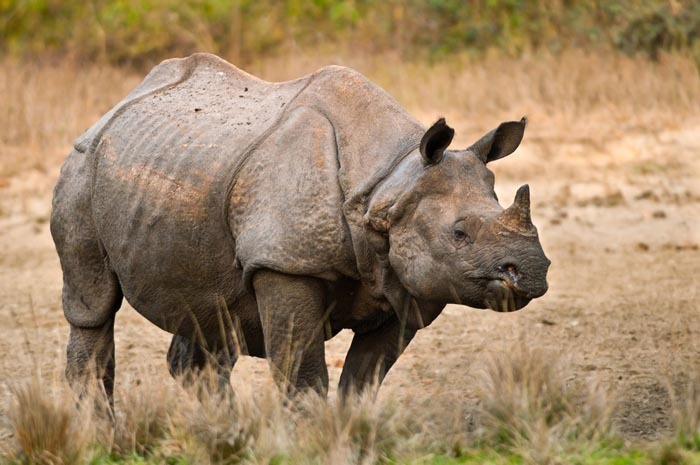The number of greater one-horned rhinos in Kaziranga National Park have increased by 12 since 2015, totalling 2,413. While any increase in rhinos makes us smile, this is just the tip of the iceberg for what this species really needs.
Greater one-horned rhinos, also sometimes called Indian rhinos, are possibly the most pre-historic looking of all rhino species. Their thick, armour-plate like skin is reminiscent of a dinosaur and with only one horn, they really are the true unicorns of the rhino world.
These rhinos have a global population of approximately 3,500 individuals and, unlike black rhinos which are ‘Critically Endangered’, Greater one-horned rhinos are classified as ‘Vulnerable’ according to the IUCN (International Union for the Conservation of Nature), mainly due to the lower threat of poaching. Once spread out across Asia, today most Greater one-horned rhinos are concentrated in just two places; Kaziranga National Park, in India and Chitwan National Park, in Nepal. These are places that the rhinos can live well, but what does it mean for the fate of the species?
Seventy percent of the global Greater one-horned rhino population live in Assam’s Kaziranga National Park; however, the species’ true range once extended from Pakistan to Myanmar, including parts of Nepal, Bangladesh and Bhutan. Due to changes in habitat use and hunting, fewer than 200 Greater one-horned rhinos remained in Northern India and Nepal by the beginning of the 20th century. Given these numbers, it is a great success that today more than 3,000 rhinos roam; however, their resident habitat range is much smaller than it once was.
Now, approximately 600 rhinos live in Nepal, mostly in Chitwan National Park in the south west of the country, and another 200 Greater one-horned rhinos live in Jaldapara National Park, in India’s West Bengal state. These luscious river-bed habitats provide thick vegetation, perfect for rhinos and other wildlife, such as elephants and tigers. Yet, having rhinos in fewer, less-connected locations, is detrimental.
Naturally, during flooding season rhinos move to higher ground, often moving into villages outside of national parks, onto agricultural land. In such situations, human-wildlife conflict is inevitable. In Jaldapara alone, there are 12 villages within the Park’s boundaries and another 48 on its periphery, bringing the area’s human population to more than 100,000. This is why it is important for rhinos to have more than one key area and space to move to suitable higher ground, but it is also the reason why local community involvement in rhino conservation projects is key.
Given the relative proximity of these areas to key rhino-horn markets (China and Vietnam) working together with villages is crucial if we are to combat poaching. Poachers have been known to pose as tourists, recruiting local villagers as guides, who then unknowingly take poachers to rhino locations. Consistent work by wildlife authorities and local communities has meant that poaching in recent years has been a reducing threat, but sadly, it still takes place. In February this year, poachers killed a rhino in Jaldapara National Park. Soon after, eight poachers from surrounding villages surrendered, pledging to give up poaching and work with others for rhino conservation.
This positive step demonstrates the value of local community engagement in showing the importance of thriving rhino populations. While poaching attempts continue, communities have to remain vigilant. And, when arrests occur, prosecutions have to be successful. Without prosecuting those nearer the top of the chain leading the poaching rings, we’ll never be able to fully stop poaching.
Since 2006, we’ve supported Greater one-horned rhino conservation efforts via our long-term friend, the International Rhino Foundation, one of the main partners in the project known as ‘Indian Rhino Vision 2020’. The vision is ambitious; aiming to build a 3,000-strong wild population of Greater one-horned rhinos by 2020, which would be spread across seven sites, rather than the-then three locations (Kaziranga, Pobitora and Orang). The project was never going to be easy. Rhino translocations are difficult at the best of times and in these areas, with fragile roads and difficult conditions, transporting 2,000 kg rhinos has been complicated, even once all the necessary infrastructure and human and other resources put in.
We’re so proud that, with your help, we can work with our partners to encourage population growth for the Greater one-horned rhino in the habitat it so desperately needs. Despite the challenges for wild populations, there are places to see these incredible rhinos in the UK and Europe, including our partner, Chester Zoo, which recently announced the arrival of a new baby Greater one-horned rhino!









